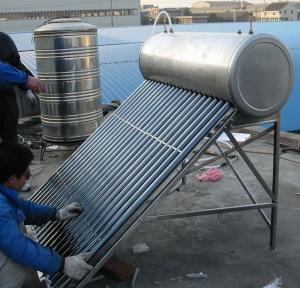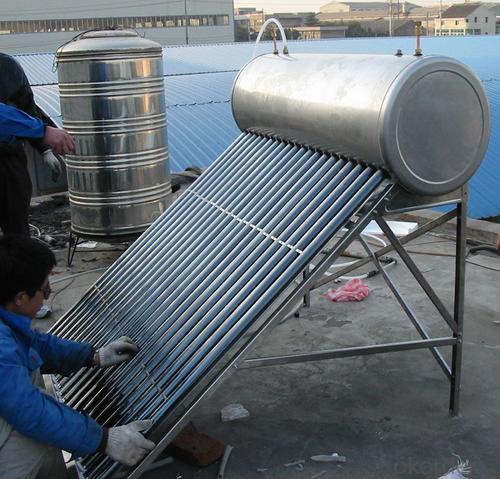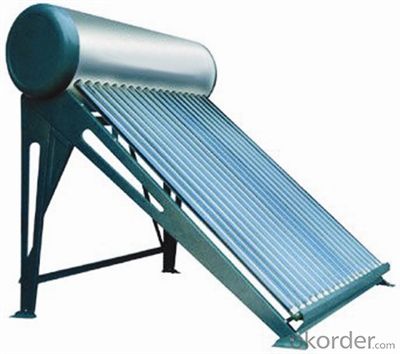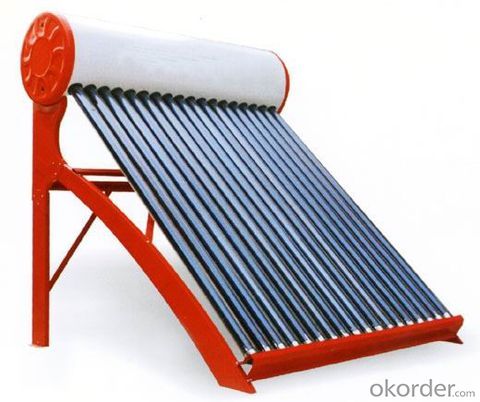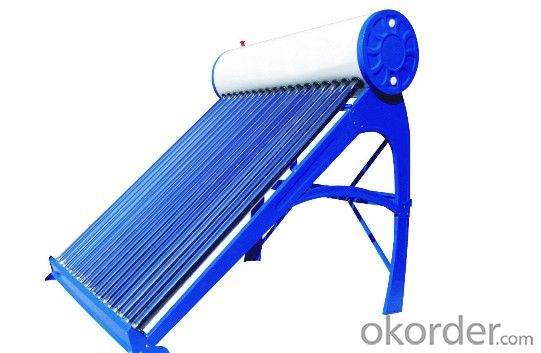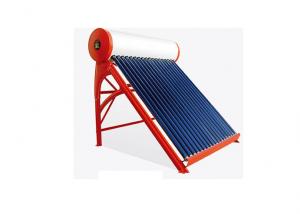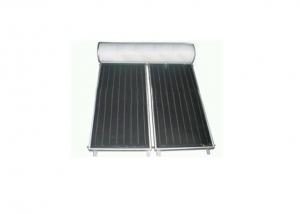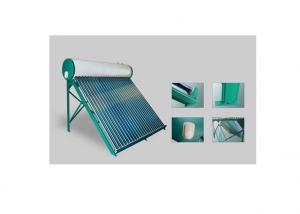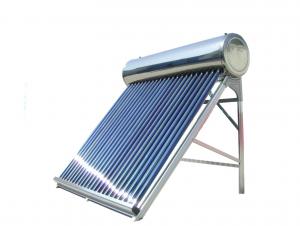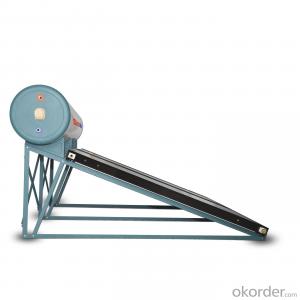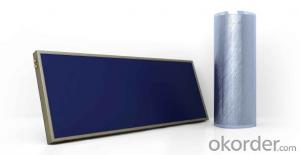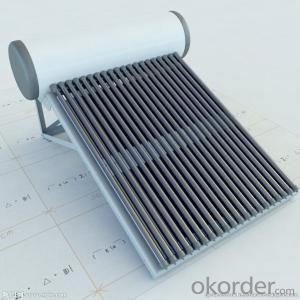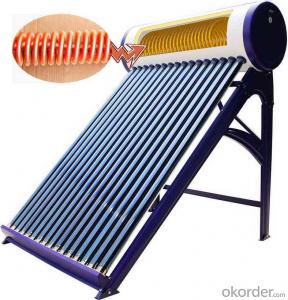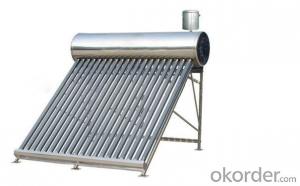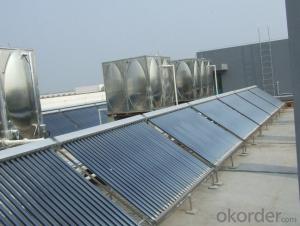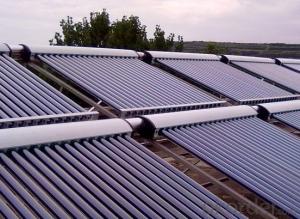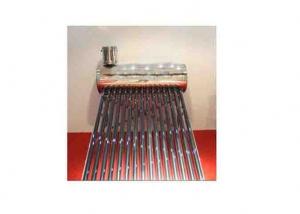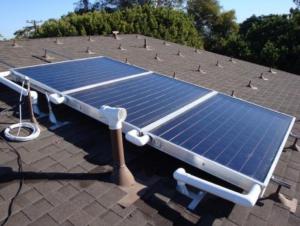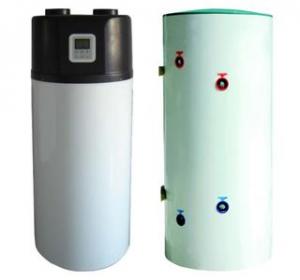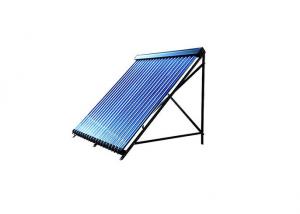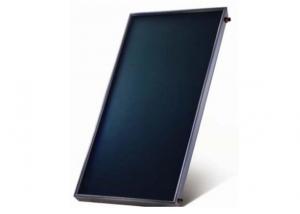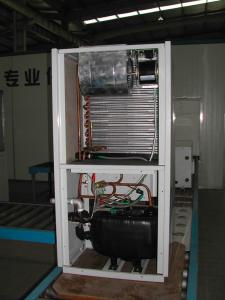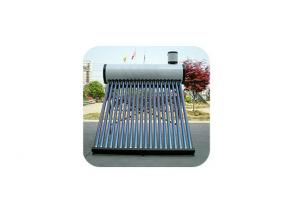Solar Water Heater Tank - Stainless Steel Non-Pressure Solar Water Heaters at Cheap Prices
- Loading Port:
- China main port
- Payment Terms:
- TT OR LC
- Min Order Qty:
- 10 set
- Supply Capability:
- 1000 set/month
OKorder Service Pledge
OKorder Financial Service
You Might Also Like
Working Principle of Domestic Solar Water Heaters:
Solar energy, in essence, is an electromagnetic wave, a type of strong optical radiation, which is produced by thermonuclear fusion reaction. The energy of the solar radiation is transmitted through the liught of different wave length. The solar water heater is designed to mainly take in the energy of visible light & near ultra red light through the selective absorbing coating of vacuum tubes.When the water in the solar collector is heated by the solar radiation, its temperature rises. As a result, the water in the solar collector and the water in the tank form natural convection because of density contrast casued by the temperature difference. So the water of the higher temperature is incessantly forced into the insulated solar water tank( As shown in the figure).
Features
<1> Imported SUS304-2B food-level stainless steel,thickness:0.31~0.5mm
<2> Outer tank: High quality stainless steel,thickness:0.31~0.5mm
<3>Insulation: 50~55mm polyurethane foam
<4> Vacuum tube: CU/SS-AL/N red tube
<5> Frame: Stainless steel/Aluminum alloy,thickness:1.2~2mm
<6> Reflector: Stainless steel/Aluminum alloy as option
<7> Available accessories: Feeding tank,solar controller,electric heater, Mag rod,thermostatic mixing valve
Specification
ITEM.NO | SPECIFICATION | EFFECTIVE LIGHT AREA | TANK'S CAPACITY | APPLICATION PEOPLE | CBM | |||
DIAMETER OF WATER TANK | QTY OF TUBE(pcs) | DIAMETER OF TUBE | LENGTH OF TUBE | |||||
Z-NS5810 | 460mm | 10 | 58mm | 1.8m | 1.04 | 100L | 4 | 0.37 |
Z-NS5812 | 460mm | 12 | 58mm | 1.8m | 1.25 | 120L | 4-5 | 0.44 |
Z-NS5815 | 460mm | 15 | 58mm | 1.8m | 1.56 | 150L | 6 | 0.56 |
Z-NS5818 | 460mm | 18 | 58mm | 1.8m | 1.87 | 180L | 7-8 | 0.64 |
Z-NS5820 | 460mm | 20 | 58mm | 1.8m | 2.08 | 200L | 8 | 0.7 |
Z-NS5825 | 460mm | 25 | 58mm | 1.8m | 2.61 | 250L | 10 | 0.89 |
Z-NS5830 | 460mm | 30 | 58mm | 1.8m | 3.13 | 300L | 12 | 1 |
Z-NS5836 | 460mm | 36 | 58mm | 1.8m | 3.75 | 360L | 14-15 | 1.3 |
Z-NS5840 | 460mm | 40 | 58mm | 1.8m | 4.17 | 400L | 16 | 1.4 |
Z-NS5845 | 460mm | 45 | 58mm | 1.8m | 4.69 | 450L | 18 | 1.6 |
Product Details Show
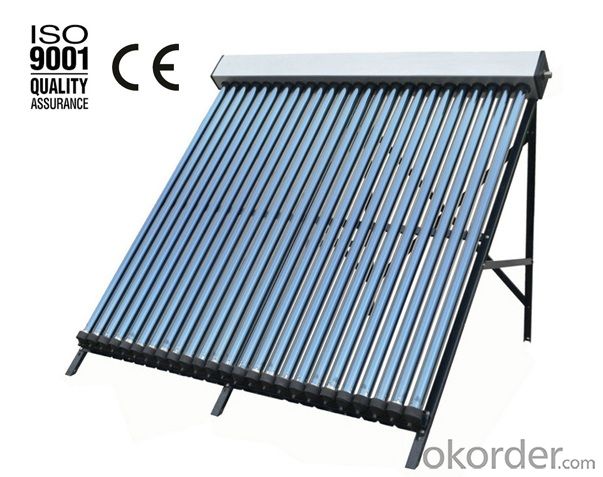
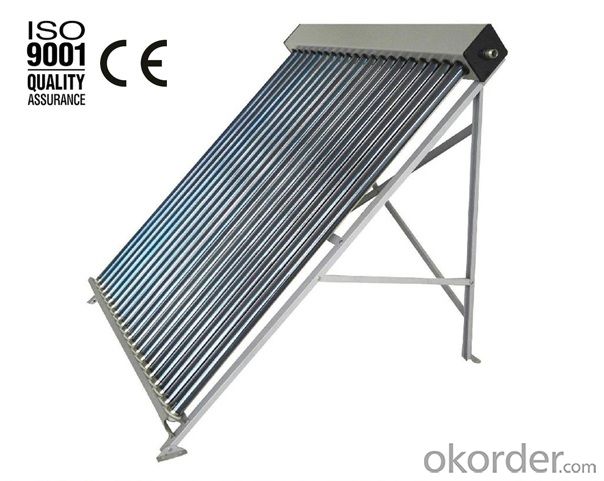
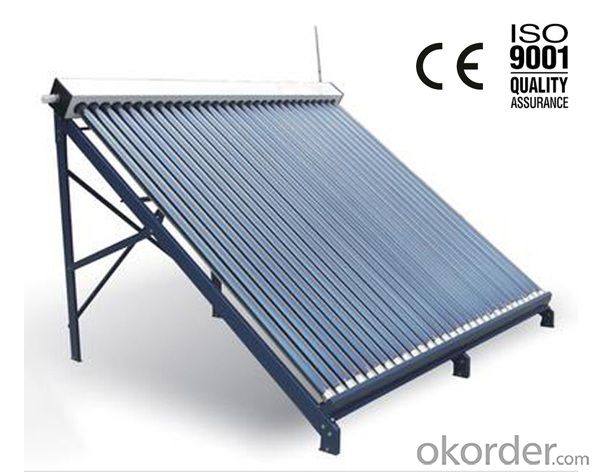
FAQ
1. Q: Are you a factory or trading company?
A: We are a factory. Especially for Solar Controller, PWM solar controller 50A12V/24V
2. Q: Where is your factory located? How can I visit there?
A: Our factory is located in Guangzhou, China. You are warmly welcomed to visit us!
3. Q: what other product you have except such Solar Lighting?
A: We have poly ,mono cells and panels. Off grid solar system, like off grid solar inverter, pure sine wave inverter, solar collector, solar controller, solar charger, Portal solar system, battery, DC Fan, Solar Led Light.
4. Q: Can the price be cheaper?
A: Of course, you will be offered a good discount for big amount.
5. How can I get a sample?
A: Please call us or send email for asking the samples.
- Q: What is the difference between active and passive solar water heaters?
- Active and passive solar water heaters are two different types of systems that harness solar energy to heat water. The main difference between them lies in how they circulate the water and transfer heat. Active solar water heaters utilize pumps or other mechanical devices to circulate water through the system. These systems typically consist of solar collectors, storage tanks, and controls. The solar collectors, usually mounted on the roof or a nearby area with ample sunlight exposure, absorb the sun's heat and transfer it to the water. The heated water is then pumped into a storage tank, where it can be used for various purposes. Active systems are more complex and require electricity to operate the pumps, but they tend to be more efficient and can provide a continuous supply of hot water. On the other hand, passive solar water heaters rely on natural convection and gravity to circulate water without the need for mechanical components. They usually consist of a solar collector and a storage tank, but without any pumps or controls. The solar collector absorbs heat from the sun, and as the water inside it heats up, it naturally rises into the storage tank due to the difference in density. As hot water is drawn from the tank, cold water is pulled down into the collector, creating a continuous flow. Passive systems are simpler and don't require electricity, but they may not be as efficient as active systems and may have limitations in terms of the amount of hot water they can provide. In summary, the main difference between active and passive solar water heaters is the method of water circulation and heat transfer. Active systems use pumps and controls to circulate water and offer higher efficiency, while passive systems rely on natural convection and gravity for circulation and are simpler but potentially less efficient. The choice between the two depends on factors such as budget, energy requirements, and available space.
- Q: Are there any safety considerations for installing a solar water heater?
- Yes, there are several safety considerations to keep in mind when installing a solar water heater. Firstly, it is important to ensure that the system is installed by a certified professional to ensure proper installation and minimize the risk of accidents. Additionally, the system should be installed in an area with proper ventilation to prevent the buildup of any potentially harmful gases. Regular maintenance and inspections are also necessary to identify and address any potential safety issues such as leaks or electrical malfunctions.
- Q: How does a solar water heater perform in cloudy or rainy weather?
- A solar water heater's performance is affected in cloudy or rainy weather as it relies on sunlight to heat the water. During such conditions, the heater's efficiency may decrease, resulting in a slower or less effective heating process. However, some solar water heaters are equipped with backup systems or can store excess heat, allowing them to continue functioning to some extent even in unfavorable weather conditions.
- Q: What is the average installation time for a solar water heater?
- The average installation time for a solar water heater can vary depending on factors such as the complexity of the system, the size of the unit, and the experience of the installer. However, on average, it typically takes around 1 to 3 days to install a solar water heater.
- Q: Can a solar water heater be used in areas with limited access to building codes and regulations?
- Yes, a solar water heater can be used in areas with limited access to building codes and regulations. Solar water heaters are relatively simple and can be installed without the need for extensive infrastructure or building permits. They can be a viable solution for providing hot water in areas where traditional water heating systems may not be feasible or accessible. However, it is important to ensure proper installation and safety measures are followed to prevent any potential hazards.
- Q: What is the environmental impact of a solar water heater?
- A solar water heater has a positive environmental impact as it significantly reduces the reliance on fossil fuels for heating water. It reduces greenhouse gas emissions and air pollution since it operates solely on renewable energy from the sun. Additionally, it conserves energy and reduces the demand for electricity or gas, contributing to a more sustainable and eco-friendly approach to water heating.
- Q: Can a solar water heater be used in apartment buildings?
- Yes, solar water heaters can be used in apartment buildings. However, the feasibility of installation depends on factors such as available roof space, orientation, and the number of units in the building. Additionally, proper plumbing and distribution systems need to be in place to ensure hot water is efficiently delivered to all units.
- Q: Can a solar water heater be used in areas with limited access to maintenance services?
- Yes, a solar water heater can be used in areas with limited access to maintenance services. Solar water heaters are generally low-maintenance systems that require minimal upkeep. They are designed to be durable and reliable, with few moving parts. Regular maintenance, such as cleaning the solar collectors and checking for any leaks or blockages, can be easily performed by the users themselves with basic tools and knowledge. Additionally, the simplicity of solar water heaters makes them less prone to breakdowns or malfunctions, reducing the need for frequent maintenance services.
- Q: Can a solar water heater be used in areas with water restrictions?
- Yes, a solar water heater can be used in areas with water restrictions. Solar water heaters use the sun's energy to heat water, reducing the need for electricity or gas. They typically have storage tanks that store heated water for later use. As long as the water restrictions allow for the use of solar energy and the limited water supply can be efficiently utilized, a solar water heater can be a sustainable and practical option in areas with water restrictions.
- Q: Are there any specific maintenance requirements for the solar collector?
- A solar collector has specific maintenance requirements that must be followed to ensure optimal performance and longevity. To maintain the system properly, the following tasks should be completed: 1. Periodically clean the solar collector to remove any dirt, dust, or debris that may accumulate. Use a soft brush or cloth along with water for cleaning. Avoid using abrasive materials or chemicals that could cause damage. 2. Regularly inspect the collector for any signs of damage, such as cracks or leaks. If any issues are found, promptly repair them to prevent further damage and maintain system efficiency. 3. If the solar collector utilizes a liquid-based heat transfer system, regularly check the fluid levels. Ensure that the fluid is at the recommended level and, if necessary, top up or replace it according to the manufacturer's instructions. 4. Monitor the system's performance, including the collector's temperature and energy generation. Investigate any significant changes or declines in performance to identify and resolve potential issues. 5. In cold climates, it may be necessary to remove snow or ice from the solar collector's surface during winter. Gently use a soft broom or a specially designed snow rake for solar panels. Consult the manufacturer's guidelines and recommendations for specific maintenance requirements for your solar collector model. Additionally, professional maintenance services are available for more extensive inspections and tasks.
Send your message to us
Solar Water Heater Tank - Stainless Steel Non-Pressure Solar Water Heaters at Cheap Prices
- Loading Port:
- China main port
- Payment Terms:
- TT OR LC
- Min Order Qty:
- 10 set
- Supply Capability:
- 1000 set/month
OKorder Service Pledge
OKorder Financial Service
Similar products
Hot products
Hot Searches
Related keywords
